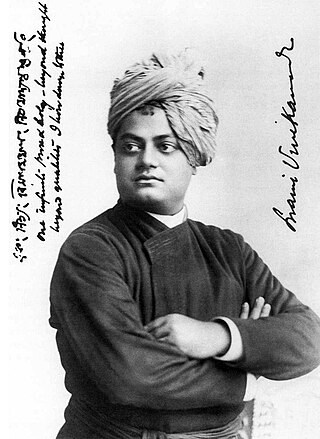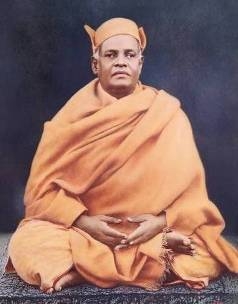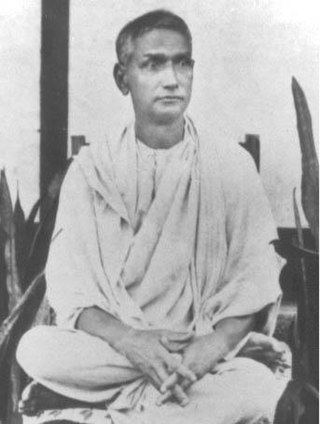
Swami Vivekananda, born Narendranath Datta, was an Indian Hindu monk, philosopher, author, religious teacher, and the chief disciple of the Indian mystic Ramakrishna. He was a key figure in the introduction of Vedanta and Yoga to the Western world, and the father of modern Indian nationalism who is credited with raising interfaith awareness and bringing Hinduism to the status of a major world religion.

Ramakrishna Math and Ramakrishna Mission (RKM) is a Hindu religious, spiritual and philanthropic organisation headquartered in Belur Math, West Bengal. The mission is named after the Indian Hindu spiritual guru and mystic Ramakrishna. The mission was founded by Ramakrishna's chief disciple Swami Vivekananda on 1 May 1897. The organisation mainly propagates the Hindu philosophy of Vedanta–Advaita Vedanta and four yogic ideals – Jnana, Bhakti, Karma, and Raja yoga. The mission bases its work on the principles of Karma Yoga, the principle of selfless work done with a dedication to God.

Sri Sarada Devi, born Kshemankari / Thakurmani / Saradamani Mukhopadhyay, was the wife and spiritual consort of Ramakrishna Paramahamsa, a nineteenth-century Hindu mystic. Sarada Devi is also reverentially addressed as the Holy Mother by the followers of the Sri Ramakrishna monastic order. The Sri Sarada Math and Ramakrishna Sarada Mission situated at Dakshineshwar is based on the ideals and life of Sarada Devi. She played an important role in the growth of the Ramakrishna Movement.
Swami Gambhirananda (1899–1988), born as Jatindranath Datta, was a Hindu sanyasi associated with Ramakrishna Mission. He was born at Sadhuhati in today's Bangladesh. He graduated from Scottish Church College, Calcutta (Kolkata).

Shuddhananda who was the fifth president of the Ramakrishna Order, was a direct monastic disciple of Vivekananda. He joined the Ramakrishna Math in 1897. He became a trustee of Ramakrishna Math and a member of the governing body of Ramakrishna Mission in May 1903. He also took up the editorship of the Bengali magazine called Udbodhan for sometime. He was appointed as the secretary of the math and the mission in 1927 and as the vice president in 1937. In 1938, he became the president of the order. His tenure was short, as he died in 1938. He is renowned in the literary circles to have translated most of Vivekananda's original works from English to Bengali.

Swami Virajananda, born Kalikrishna Bose, was an initiated disciple of Sarada Devi and the sixth president of the Ramakrishna Order. Born as the son of Trailokyanath Bose and Nishadkalidevi, Virajananda was the first person to join the Ramakrishna Order after the direct disciples of Ramakrishna. In 1897, he was initiated into sannyasa by Vivekananda. From 1899 onward he served in Advaita Ashrama, Mayavati and became its president in 1906. He is recognised as a monastic disciple of Vivekananda.

Ramakrishna Math is the administrative legal organization of the Ramakrishna Order, considered part of the Hindu reform movements. It was set up by sanyasin disciples of Ramakrishna Paramhansa headed by Swami Vivekananda at Baranagar Math in Baranagar, a place near Calcutta, in 1886. India. The headquarters of Ramakrishna Math and its twin organisation, Ramakrishna Mission is at Belur Math.

Ramakrishna Paramhansa Deva had sixteen direct disciples who became monks of the Ramakrishna Order; they are often considered his apostles. In the Ramakrishna-Vivekananda movement, the apostles have played an important role. Apart from Swami Vivekananda, the direct disciples or apostles of Ramakrishna were as follows.

Vedanta Societies refer to organizations, groups, or societies formed for the study, practice, and propagation of Vedanta, the culmination of Vedas. More specifically, they "comprise the American arm of the Indian Ramakrishna movement", and refer to branches of the Ramakrishna Order located outside India.

Balaram Bose was one of the prominent householder disciples of Ramakrishna Paramahamsa. He was the son of Radhamohan Bose. He is often referred in The Gospel of Sri Ramakrishna. Ramakrishna often visited his house and participated in kirtana and other devotional functions. Sri Maa Sarada Devi and some other devotees of the master, including Swami Adbhutananda lived in the house of Balaram Bose after the master's death. He was a great philanthropist and donated regularly to government and civilian organizations.

Ramakrishna Sarada Math is a religious monastic order, considered part of the Hindu reform movements. It was established in 1929 at Bagbazar, Kolkata.

Swami Turiyananda or "Hari Maharaj" as he was popularly known as, was a direct monastic disciple of Ramakrishna, the 19th-century Hindu mystic from Bengal. He was one of the earliest missionary to be sent by his leader and brother disciple Swami Vivekananda to the United States of America to preach the message of Vedanta to the western audience from 1899 to 1902. He established the Shanti Ashrama in California, United States. He was a monk of the Ramakrishna Mission. He left his mortal body in Varanasi, India.

Saradananda, also known as Swami Saradananda, was born as Sarat Chandra Chakravarty in 1865, and was one of the direct monastic disciples of Ramakrishna. He was the first Secretary of the Ramakrishna Math and Ramakrishna Mission, a post which he held until his death in 1927. He established the Udbodhan house in the Bagbazar area of Calcutta, which was built primarily for the stay of Sri Sarada Devi in Calcutta, from where he used to publish the Bengali magazine Udbodhan. There he wrote Sri Sri Ramakrishna Lilaprasanga in Bengali, on the life of Ramakrishna, which was translated into English as Sri Ramakrishna, the Great Master. He is believed to be reincarnation of Saint Peter and he allegedly went into Samadhi when he was in the Saint Peter Church and said that "I remembered my past" and wrote in his diary that "Saint Peter again."

Nirmalananda, born as Tulasi Charan Dutta in Calcutta, was a direct disciple of Ramakrishna, the 19th-century mystic and Hindu saint from India, and took Sanyasa from Vivekananda along with Brahmananda and others. He was initiated by Sri Ramakrishna, on which fact a few latter-day antagonists tried to cast doubt in the Bangalore Court, but into which question the Court refused to get into. Nirmalananda played a key role in establishing Ramakrishna Math and Mission chiefly in South India, in Kerala and Bangalore and Tamil Nadu and also in the USA, Burma and Bangladesh.

Baranagar Math or Ramakrishna Math, Baranagar was the first monastery of Ramakrishna Order. In September 1886, after the death of Ramakrishna, when his devotees stopped funding, Swami Vivekananda and other disciples of Ramakrishna decided to make a dilapidated house at Baranagar their new math. The house crumbled to dust in 1897. In 1973 Vivekananda Math Samrakshan Samity was formed who attempted to preserve the area. In 2001, the possession was handed over to Belur Math authority, who soon-after declared it as one of their official branch. The restoration and development work of the area is still going on.

Achalananda, popularly known as Kedar Baba, was a direct monastic disciple of Vivekananda and the founder of Ramakrishna Mission Home of Service, in Varanasi. He initially worked as a policeman, but was then influenced by the ideology of Vivekananda.

Swami Prakashananda (1874–1927) was a monastic disciple of Vivekananda and a monk of the Ramakrishna Order who played a major role in propagating and promoting the Vedanta philosophy and Vivekananda's message in India and America. He came to the US in 1906 to serve under Trigunatitananda, a direct disciple of Ramakrishna at the Vedanta Society of San Francisco, later renamed as Vedanta Society of Northern California, and later became its president.
Vimalananda (1872–1908) was an Indian spiritual writer who was one of the monastic disciples of Vivekananda and an early monk of the Ramakrishna Order. He was involved in the publication of Prabuddha Bharata. He was actively involved in running day-to-day operations of the Advaita Ashrama at Mayavati during the early days of the Ashrama. He also inaugurated the Ramakrishna Math at Ulsoor in Bangalore in 1906. He died in 1908 at the Mayavati Ashrama.
Sri Sarada Math is named after Sri Sarada Devi, the consort of Sri Ramakrishna, and founded on 2 December 1954. Built by a group of eight sadhavis, as per the instructions given by Swami Vivekananda, it serves as a monastic order for women. Headquartered at Dakshineshwar, Kolkata, the organisation has branch centres all over India, in Sri Lanka and Australia. The nuns of this order use the title "Pravrajika" before their ordained name, and are usually addressed as "Mataji" meaning 'revered mother'.
















